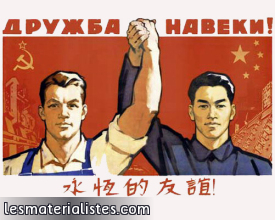Chinese people's communes - 4 : The rightist trend and the struggle against it
Submitted by Anonyme (non vérifié)However, a revisionist trend was already gaining strength in the Party itself. It opposed collectivization, upholding the same views as Tito, Gomulka, etc. in the Eastern European countries.
With Khrushchev's attacks on Stalin and its coup in the Soviet Union, Chinese revisionists felt that they had the possibility to take power, too. A sign of this can be seen in the mention of Mao's name by Liu Shaoqi, president of the country: 104 times in the 1954 report of the congress of the Communist Party of China, 4 times only in 1956.
It was not all: in 1956 the Party also suppressed from its constitution the principle of “Mao Zedong thought”. In this sense, the Hundred flowers campaign was taken advantage of by the revisionists to promote criticism of the regime and to stage a counter-revolutionary coup.
It is also the meaning of the document of the Communist Party of China about the question of Stalin, which defends him against open criticism made by Khrushchev, but in a rather contradictory and mild manner. It is easy to see this as a “compromise”, that would soon disappear when the two-lines struggle would break out.
It is necessary to recall who were the main protagonists in the direction of the Party. Mao Zedong was the leader, but there was also Liu Shaoqi, who was a rightist and was considered as the “number 2”, who played a key role in the internal affairs of the Party.
Zhou Enlai, the prime minister, was rather “centrist”, and played a major role in the international affairs, but also in the administration. We also have Deng Xiaoping, head of the secretariat of the Communist Party of China, who was soon to become the leader of the rightist faction.
 So, the Party, which had 4,5 millions members in 1949 and 10,7 millions members in 1956, was stronger and better organized, but infiltrated by the revisionists.
So, the Party, which had 4,5 millions members in 1949 and 10,7 millions members in 1956, was stronger and better organized, but infiltrated by the revisionists.
Nevertheless, at that time, the Party still managed to react firmly with another campaign, called the Anti-Rightist Movement, targeting more than 500 000 people.
And the line had to be rectified, so as to avoid the triumph of revisionism. The first step was, already, the nationalization of the last capitalistic remains of the industry, trade and crafts.
 In 1956, all the industrial enterprises belonged either to the state only (67,5% of them), or to joint public-private projects. Nearly 92% of the handicraft workers were also organized in cooperatives.
In 1956, all the industrial enterprises belonged either to the state only (67,5% of them), or to joint public-private projects. Nearly 92% of the handicraft workers were also organized in cooperatives.
In the same way, agriculture was collectivized and Mao had a central role in the drafting of a “national agricultural program”. A “small leap” was produced, with a 60% increase in investments.
Mao Zedong then published a new document called “On the ten major relationships”; he wanted a slight change in the ratio of light industrial investment to heavy industrial investment, from 1 to 8 to 1 to 7. The goal was to support collectivized agriculture, with light industrial raw material.
This was all the more necessary as, in 1956, 6,3 millions of people had moved to the cities, causing to draw one-seventh of the state grain reserve. A balanced development of the socialist economy was very difficult to achieve, and the situation in China was complex, notwithstanding the huge flooding of 1956 and another bad harvest in 1967, also due to weather conditions.
 The planning capacities were very weak. The State Planning Commission could only organize the production of 28 items for national distribution in 1952. This number rose to 96 in 1953, 134 in 1954, 163 in 1955, and 235 in 1956.
The planning capacities were very weak. The State Planning Commission could only organize the production of 28 items for national distribution in 1952. This number rose to 96 in 1953, 134 in 1954, 163 in 1955, and 235 in 1956.
These were not the only problems. Collectivization was clearly hindered by an administrative approach, far away from local priorities, leaning towards bureaucracy.
As the “Hundred Flowers” Campaign was not able to solve the problems, it was ended on June 8, 1957, by an editorial in the Renmin Ribao, the People's Daily, and another move was made: it was the Great Leap Forward.
The goal was indeed to find a way between the rightists who wanted a liberal policy in the countryside and an end to collectivization, and the others who wanted to follow the bureaucratic model prevailing in Khruchtchev's USSR. Naturally, this was only a question of priority among the rightists, because both camps shared those values.
All the rightists wanted more flexibility in the liberal sense, with the individual at the core of the process.
